CVPR
2004
IEEE
15 years 8 months ago
2004
IEEE
We propose a geometric approach to 3-D motion segmentation from point correspondences in three perspective views. We demonstrate that after applying a polynomial embedding to the ...
CVPR
2004
IEEE
15 years 8 months ago
2004
IEEE
While motion estimation has been extensively studied in the computer vision literature, the inherent information redundancy in an image sequence has not been well utilised. In par...
CVPR
2004
IEEE
15 years 8 months ago
2004
IEEE
Silhouettes contain rich information about the shape of objects that can be used for recognition and classification. We present a novel approach that allows us to reliably compute...
CVPR
2004
IEEE
15 years 8 months ago
2004
IEEE
Range imaging has become a critical component of many computer vision applications. The quality of the depth data is of critical importance, but so is the need for speed. Shuttere...
CVPR
2004
IEEE
15 years 8 months ago
2004
IEEE
We model the dynamic geometry of a time-varying scene as a 3D isosurface in space-time. The intersection of the isosurface with planes of constant time yields the geometry at a si...
CVPR
2004
IEEE
15 years 8 months ago
2004
IEEE
Most tracking algorithms are based on the maximum a posteriori (MAP) solution of a probabilistic framework called Hidden Markov Model, where the distribution of the object state a...
CVPR
2004
IEEE
15 years 8 months ago
2004
IEEE
Multibody factorization algorithms [2, 1, 16] give an elegant and simple solution to the problem of structure from motion even for scenes containing multiple independent motions. ...
CVPR
2004
IEEE
15 years 8 months ago
2004
IEEE
In this paper we perform 3D face tracking on corrupted video sequences. We use a deformable model, combined with a predictive filter, to recover both the rigid transformations and...
CVPR
2004
IEEE
15 years 8 months ago
2004
IEEE
This paper describes a head-tracking algorithm that is based on recognition and correlation-based weighted interpolation. The input is a sequence of 3D depth images generated by a...
CVPR
2004
IEEE
15 years 8 months ago
2004
IEEE
A new and fast way to find local image correspondences for wide baseline image matching is described. The targeted application is visual navigation, e.g. of a semi-automatic wheel...

